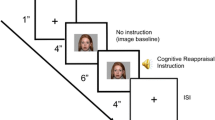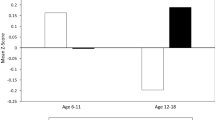Abstract
Both autism spectrum (ASD) and anxiety disorders are associated with atypical neural and attentional responses to emotional faces, differing in affective face processing from typically developing peers. Within a longitudinal study of children with ASD (23 male, 3 female), we hypothesized that early ERPs to emotional faces would predict concurrent and later ASD and anxiety symptoms. Greater response amplitude to fearful faces corresponded to greater social communication difficulties at age 3, and less improvement by age 14. Faster ERPs to neutral faces predicted greater ASD symptom improvement over time, lower ASD severity in adolescence, and lower anxiety in adolescence. Early individual differences in processing of emotional stimuli likely reflect a unique predictive contribution from social brain circuitry early in life.




Similar content being viewed by others
References
Amaral, D. G., Behniea, H., & Kelly, J. L. (2003). Topographic organization of projections from the amygdala to the visual cortex in the macaque monkey. Neuroscience, 188, 1099–1120.
Ashwin, C., Baron-Cohen, S., Wheelwright, S., O’Riordan, M., & Bullmore, E. T. (2007). Differential activation of the amygdala and the ‘social brain’ during fearful face-processing in Asperger Syndrome. Neuropsychologia, 45(1), 2–14.
Bar-Haim, Y., Lamy, D., & Glickman, S. (2005). Attentional bias in anxiety: A behavioral and ERP study. Brain and Cognition, 59, 11–22.
Baron-Cohen, S. (2005). Mindblindness: An essay on autism and theory of mind. Cambridge, MA: MIT Press.
Baron-Cohen, S., Baldwin, D. A., & Crowson, M. (1997). Do children with autism use the speaker’s direction of gaze strategy to crack the code of language? Child Development, 68(1), 48–57.
Beauchaine, T. P., & Webb, S. J. (in press). Developmental processes and psychophysiology. In J. T. Cacioppo, L. G. Tassinary, & G. G. Berntson (Eds.), Handbook of psychophysiology (4th ed.). Newyork: Cambridge University Press.
Bentin, S., Allison, T., Puce, A., Perez, E., & McCarthy, G. (1996). Electrophysiological studies of face perception in humans. Journal of Cognitive Neuroscience, 8(6), 551–565. doi:10.1162/jocn.1996.8.6.551.
Blakeley-Smith, A., Reaven, J., Ridge, K., & Hepburn, S. (2012). Parent-child agreement of anxiety symptoms in youth with autism spectrum disorders. Research in Autism Spectrum Disorders, 6, 707–716.
Bryk, A. S., & Raudenbush, S. W. (1992). Hierarchical linear models. Newbury Park, CA: Sage.
Campbell, D. J., Shic, F., Macari, S., & Chawarska, K. (2014). Gaze response to dyadic bids at 2 years related to outcomes at 3 years in autism spectrum disorders: A subtyping analysis. Journal of Autism and Developmental Disorders, 44, 431–442.
Dawson, G., & Bernier, R. A. (2007). Social brain circuitry in autism. In D. Coch, G. Dawson, & K. Fischer (Eds.), Human behavior and the developing brain (2nd ed.). New York, NY: Guilford Press.
Dawson, G., Webb, S. J., Carver, L., Panagiotides, H., & McPartland, J. (2004). Young children with autism show atypical brain responses to fearful versus neutral facial expressions of emotion. Developmental Science, 7(3), 340–359.
Dawson, G., Webb, S. J., & McPartland, J. (2005). Understanding the nature of face processing impairment in autism: Insights from behavioral and electrophysiological studies. Developmental Neuropsychology, 27(3), 403–424.
Deely, Q., Daly, E. M., Surguladze, S., Page, L., Toal, F., Robertson, D., et al. (2007). An event related functional magnetic resonance imaging study of facial emotion processing Asperger Syndrome. Biological Psychiatry, 62, 207–217.
de Klerk, C. C. J. M., Gliga, T., Charman, T., Johnson, M. H., & The BASIS Team. (2014). Face engagement during infancy predicts later face recognition ability in younger siblings of children with autism. Developmental Science, 17(4), 596–611.
Ekman, P., & Friesen, W. V. (1976). Pictures of facial affect. Palo Alto, CA: Consulting Psychologists Press.
Eldar, S., Yankelevitch, R., Lamy, D., & Bar-Haim, Y. (2010). Enhanced neural reactivity and selective attention to threat in anxiety. Biological Psychology, 85, 252–257.
Elsabbagh, M., Mercure, E., Hudry, K., Chandler, S., Pasco, G., Charman, T., et al. (2012). Infant neural sensitivity to dynamic eye gaze is associated with later emerging autism. Current Biology, 22(4), 338–342.
Fox, E., Russo, R., Bowles, R., & Dutton, K. (2007). Do threatening stimuli draw or hold visual attention in subclinical anxiety? Journal of Experimental Psychology: General, 130(4), 681–700.
Gauthier, I., Curran, T., Curby, K. M., & Collins, D. (2003). Perceptual interference supports a non-modular account of face processing. Nature Neuroscience, 6(4), 428–432.
Golarai, G., Grill-Spector, K., & Reiss, A. L. (2006). Autism and the development of face processing. Clinical Neuroscience Research, 6, 145–160.
Gotham, K., Pickles, A., & Lord, C. (2009). Standardizing ADOS scores for a measure of severity in autism spectrum disorders. Journal of Autism and Developmental Disorders, 39(5), 693–705.
Gotham, K., Risi, S., Pickles, A., & Lord, C. (2007). The Autism Diagnostic Observation Schedule: Revised algorithms for improved diagnostic validity. Journal of Autism and Developmental Disorders, 37(4), 613–627.
Hankin, B. L., Gibb, B. E., Abela, J. R. Z., & Flory, K. (2010). Selective attention to affective stimuli and clinical depression among youth: Role of anxiety and specificity of emotion. Journal of Abnormal Psychology, 119(3), 491–501.
Hileman, C. M., Henderson, H., Mundy, P., Newell, L., & Jaime, M. (2011). Developmental and individual differences on the P1 and N170 ERP components in children with and without autism. Developmental Neuropsychology, 36, 214–236.
Ingersoll, B., & Wainer, A. (2013). Initial efficacy of Project ImPACT: A parent-mediated social communication intervention for young children with ASD. Journal of Autism and Developmental Disorders, 43, 2943–2952.
Johnson, M. H., Senju, A., & Tomalski, P. (2015). The two-process theory of face processing: modifications based on two decades of data from infants and adults. Neuroscience and Biobehavioral Reviews, 50, 169–179. doi:10.1016/j.neubiorev.2014.10.009.
Jones, W., & Klin, A. (2013). Attention to eyes is present but in decline in 2–6-month-old infants later diagnosed with autism. Nature, 504, 427–431.
Kanwisher, N. (2000). Domain specificity in face perception. Nature Neuroscience, 3(8), 759–763.
Lord, C., Rutter, M., DiLavore, P. C., & Risi, S. (2003). Autism Diagnostic Observation Schedule manual. Los Angeles, CA: Western Psychological Services.
Lord, C., Rutter, M. L., Goode, S., & Heemsbergen, J. (1989). Autism Diagnostic Observation Schedule: A standardized observation of communicative and social behavior. Journal of Autism and Developmental Disorders, 19, 185–212.
Lord, C., Rutter, M., & Le Couteur, A. (1994). Autism Diagnostic Interview—Revised: A revised version of a diagnostic interview for caregivers of individuals with possible pervasive developmental disorders. Journal of Autism and Developmental Disorders, 24, 659–685.
Lozier, L. M., Vanmeter, J. W., & Marsh, A. A. (2014). Impairments in facial affect recognition associated with autism spectrum disorders: A meta-analysis. Developmental Psychopathology. doi:10.1017/s0954579414000479.
May, T., Cornish, K., & Rinehart, N. J. (2015). Parent–child agreement using the Spence Children’s Anxiety Scale and thermometer in children with autism spectrum disorder. Autism Research and Treatment, Article ID 315495.
Mogg, K., Garner, M., & Bradley, B. P. (2007). Anxiety and orienting of gaze to angry and fearful faces. Biological Psychology, 76, 163–169.
Morton, J., & Johnson, M. H. (1991). CONSPEC and CONLERN: A two-process theory of infant face recognition. Psychological Review, 98(2), 164–181.
Mullen, E. M. (1997). Mullen scales of early learning. Los Angeles, CA: Western Psychological Services.
Neuhaus, E., Beauchaine, T. P., & Bernier, R. (2010). Neurobiological correlates of social functioning in autism. Clinical Psychology Review, 30(6), 733–748.
Neuhaus, E., Bernier, R., & Beauchaine, T. P. (2014). Social skills, internalizing and externalizing symptoms, and respiratory sinus arrhythmia in autism. Journal of Autism and Developmental Disorders, 44, 730–737.
O’Toole, L. J., DeCicco, J. M., Berthod, S., & Dennis, T. A. (2013). The N170 to angry faces predicts anxiety in typically developing children over a two-year period. Developmental Neuropsychology, 38(5), 352–363.
Osterling, J., & Dawson, G. (1994). Early recognition of children with autism: A study of first birthday home videotapes. Journal of Autism and Developmental Disorders, 24(3), 247–257.
Ozonoff, S., Iosif, A. M., Baquio, F., Cook, I. C., Hill, M. M., Rogers, S. J., et al. (2010). A prospective study of the emergence of early behavioral signs of autism. Journal of the American Academy of Child and Adolescent Psychiatry, 49(3), 256–266.
Ozsivadjian, A., Hibberd, C., & Hollocks, M. J. (2014). The use of self-report measures in young people with autism spectrum disorder to access symptoms of anxiety, depression, and negative thoughts. Journal of Autism and Developmental Disorders, 44, 969–974.
Phelps, E. A., & LeDoux, J. E. (2005). Contributions of the amygdala to emotion processing: From animal models to human behavior. Neuron, 48, 175–187.
Reynolds, C. R., & Richmond, B. O. (1997). What I think and feel: A revised measure of children’s manifest anxiety. Journal of Abnormal Child Psychology, 25, 15–20.
Rothbart, M. K., Sheese, B. E., Rueda, M. R., & Posner, M. I. (2011). Developing mechanisms of self-regulation in early life. Emotion Review, 3, 207–213.
Siller, M., & Sigman, M. (2008). Modeling longitudinal change in the language abilities of children with autism: Parent behaviors and child characteristics as predictors of change. Developmental Psychology, 44, 1691–1704.
Simonoff, E., Pickles, A., Charman, T., Chandler, S., Loucas, T., & Baird, G. (2008). Psychiatric disorders in children with autism spectrum disorders: Prevalence, comorbidity, and associated factors in a population-derived sample. Journal of the American Academy of Child and Adolescent Psychiatry, 47(8), 921–929.
Taylor, M. J., Batty, M., & Itier, R. J. (2001). The faces of development: A review of early face processing over childhood. Journal of Cognitive Neuroscience, 16, 1426–1442.
Thomas, K. M., Drevets, W. C., Dahl, R. E., Ryan, N. D., Birmaher, B., Eccard, C. H., et al. (2001). Amygdala response to fearful faces in anxious and depressed children. Archives of General Psychiatry, 58, 1057–1063.
Tucker, D. (1993). Spatial sampling of head electrical fields, the geodesic sensor net. Electroencephalography and Clinical Neurophysiology, 87, 154–163.
Webb, S. J., Dawson, G., Bernier, R., & Panagiotides, H. (2006). ERP evidence of atypical face processing in young children with autism. Journal of Autism and Developmental Disorders, 36, 881–890.
Webb, S. J., Jones, E. J. H., Merkle, K., Namkung, J., Toth, K., Greenson, J., et al. (2010). Toddlers with elevated autism symptoms show slowed habituation to faces. Child Neuropsychology: A Journal on Normal and Abnormal Development in Childhood and Adolescence, 16(3), 255–278.
Webb, S. J., Neuhaus, E., & Faja, S. (in press). Face perception and learning in autism spectrum disorders. The Quarterly Journal of Experimental Psychology. doi:10.1080/17470218.2016.1151059.
Acknowledgments
Support for this project was provided by NICHD and NIDCD PO1HD34565 and an Autism Speaks Meixner Translational Postdoctoral Fellowship (Neuhaus).
Author Contributions
Conceptualization: GD, SW, AE; Methodology: GD, SW, AE, JM; Formal Analysis: EJ, EN; Investigation: SW, AE, LS, KB, EN; Writing - Original Draft: EN, SW; Writing - Review & Editing: all authors; Project Administration: GD, AE, SW.
Author information
Authors and Affiliations
Corresponding author
Ethics declarations
Ethical Approval
All procedures performed in studies involving human participants were in accordance with the ethical standards of the institutional and/or national research committee and with the 1964 Helsinki declaration and its later amendments or comparable ethical standards.
Rights and permissions
About this article
Cite this article
Neuhaus, E., Jones, E.J.H., Barnes, K. et al. The Relationship Between Early Neural Responses to Emotional Faces at Age 3 and Later Autism and Anxiety Symptoms in Adolescents with Autism. J Autism Dev Disord 46, 2450–2463 (2016). https://doi.org/10.1007/s10803-016-2780-y
Published:
Issue Date:
DOI: https://doi.org/10.1007/s10803-016-2780-y




